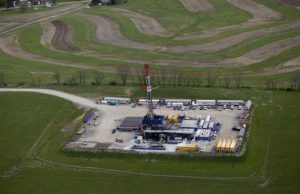Sino-US plans to work together on climate change could trigger a new shale gas boom, fuelled by US technology and Chinese cash, say experts.
During a visit by US Secretary of State John Kerry to China in April, the two countries issued a joint statement on climate change and announced plans for a new working group “to determine and finalise ways in which they can advance cooperation on technology, research, conservation, and alternative and renewable energy”.
Though it is too early to say what concrete actions will be taken under this partnership, experts are predicting a new emphasis on shale gas, which has already transformed the energy landscape in the US.
At 36 trillion cubic metres, China’s shale gas reserves are double those of the US, according to estimates from the US Energy Information Administration. But development of the sector is still at a primitive stage, presenting opportunities for US involvement.
“There is a natural marriage of interest here. This would benefit American companies. It would benefit China,” said Jonathan Pollack, director of the Washington DC-based John L. Thornton China Center. “China clearly has some potential here for developing shale gas, as do a number of other countries, but the US can expedite that process. It doesn’t do any country any good to just sit on its resources.”
China doesn’t intend to sit. The government has set a target of extracting 6.5 billion cubic metres of shale gas per year by 2015 and 100 billion cubic metres by 2020. It’s not a question of whether China can copy the US trajectory, but “how soon it can be achieved" said the US under secretary of state for economic growth, energy, and the environment Robert Hormats at the Boao Forum – Asia’s equivalent of Davos – in April.
US technology, Chinese cash
China’s zeal for domestic shale gas extraction is hardly surprising given its increasing dependence on foreign energy sources. The International Energy Agency (IEA) has predicted the country will need to import nearly 80% of its oil by 2030.
However, despite China’s determination and resources, some observers say it will be difficult for China to fully realise its shale gas potential without US technological cooperation.
“China has enormous potential in shale gas as well. But as far as technology is concerned, of course the US is far advanced. So the question is how you bridge these years in between,” said Thomas Matussek, managing director of Deutsche Bank’s Alfred Herrhausen Society and former senior German diplomat, ahead of a conference on China’s resource security in Beijing.
Many say the answer lies in increased cooperation. China, lacking technology and experience of drilling in unconventional fields, is keen to harness the know-how of its US counterparts. America, meanwhile, could do with cash from China to further fuel its shale gas revolution. Speaking at the Boao Forum in April, Margaret Ren, chairman of Bank of America Merrill Lynch China, said Chinese companies could access advanced technology by investing in the US market.
Chinese companies appear to understand this already. In late February, energy giant Sinopec inked a one-billion-dollar deal to buy half of Chesapeake Energy’s oil and gas assets in Oklahoma, boosting its US presence. Another Chinese state-owned energy conglomerate, Sinochem, bought the Wolfcamp shale field for US$1.7 billion from Pioneer Natural Resources.
Environmental concerns
But even if Chinese companies get hold of more advanced technology through cooperation with the US, there is no guarantee China can successfully replicate the US shale gas revolution. China’s geology is different, and Chinese shale gas deposits lie much deeper under the surface than in the US.
There are also serious environmental concerns. Shale gas cooperation may happen under the guise of joint action to protect the climate, but activists like Bill McKibben argue investment in unconventional gas – less carbon intensive than, say, coal, but still a fossil fuel – is a “distraction” from development of renewable energies.
Water scarcity is also a major constraint. Even to achieve the relatively moderate 2015 target would mean consuming a third of the total amount of water already used by China’s entire industrial sector, according to the BBC.
US campaign group the Natural Resources Defense Council this week called for the new working group to heed the environmental lessons of America’s shale gas boom and establish strong safeguards for shale-gas development “in order to protect and conserve precious water resources used to extract the gas, minimise methane and other air pollutant emissions and protect public health.”




